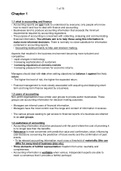Samenvatting
Summary Accounting and Finance for Non-Specialists 11th edition + MyLab Accounting, ISBN: 9781292244099 Finance & Accounting
- Instelling
- NHL Stenden Hogeschool (NHL)
Summary Accounting and Finance for Non-Specialists 11th edition + MyLab Accounting, ISBN: 4099 Finance & Accounting Summary of my accounting lab, spare yourself spending a lot of hours practicing online by using this document. Easy to pass! Written in English, a few Dutch assignment notes ar...
[Meer zien]





